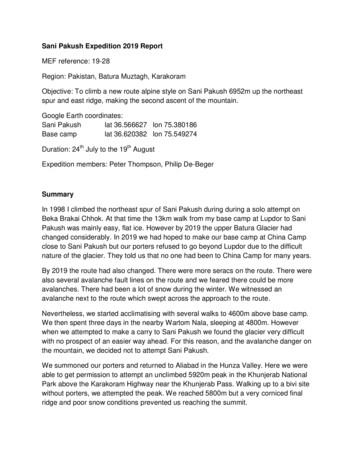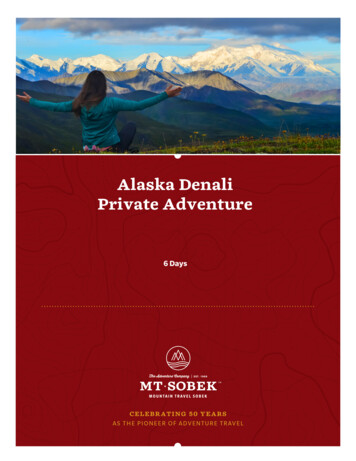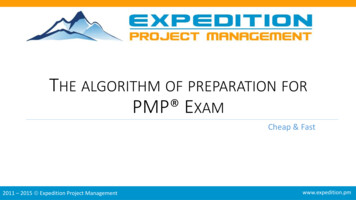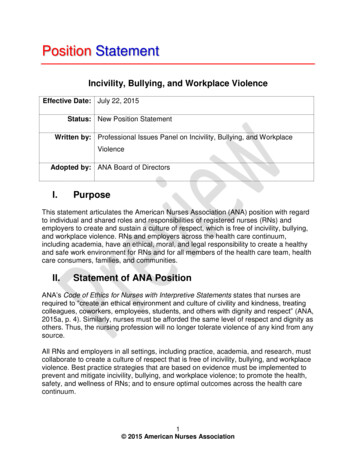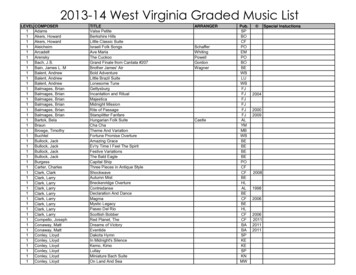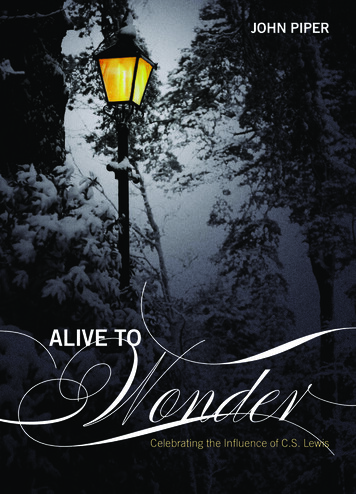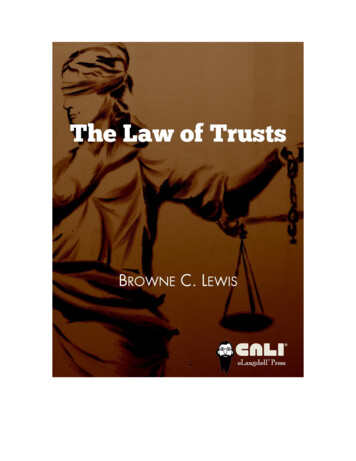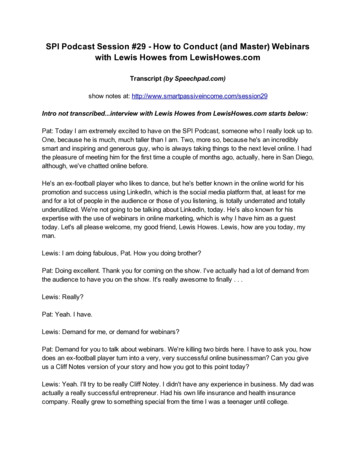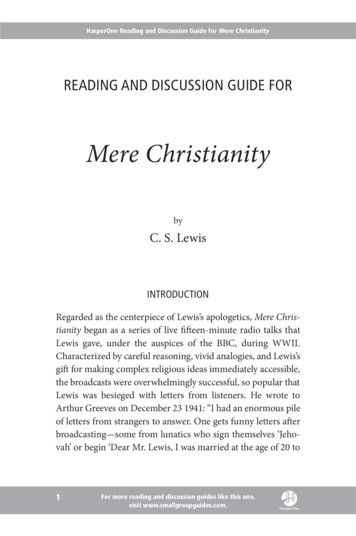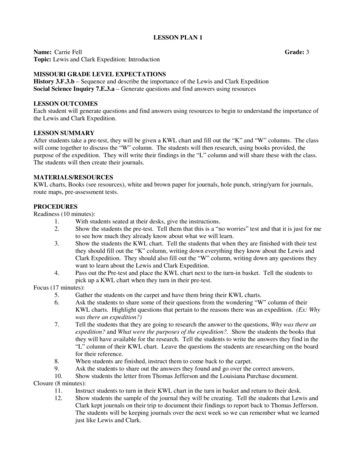
Transcription
LESSON PLAN 1Name: Carrie FellTopic: Lewis and Clark Expedition: IntroductionGrade: 3MISSOURI GRADE LEVEL EXPECTATIONSHistory 3.F.3.b – Sequence and describe the importance of the Lewis and Clark ExpeditionSocial Science Inquiry 7.E.3.a – Generate questions and find answers using resourcesLESSON OUTCOMESEach student will generate questions and find answers using resources to begin to understand the importance ofthe Lewis and Clark Expedition.LESSON SUMMARYAfter students take a pre-test, they will be given a KWL chart and fill out the “K” and “W” columns. The classwill come together to discuss the “W” column. The students will then research, using books provided, thepurpose of the expedition. They will write their findings in the “L” column and will share these with the class.The students will then create their journals.MATERIALS/RESOURCESKWL charts, Books (see resources), white and brown paper for journals, hole punch, string/yarn for journals,route maps, pre-assessment tests.PROCEDURESReadiness (10 minutes):1.With students seated at their desks, give the instructions.2.Show the students the pre-test. Tell them that this is a “no worries” test and that it is just for meto see how much they already know about what we will learn.3.Show the students the KWL chart. Tell the students that when they are finished with their testthey should fill out the “K” column, writing down everything they know about the Lewis andClark Expedition. They should also fill out the “W” column, writing down any questions theywant to learn about the Lewis and Clark Expedition.4.Pass out the Pre-test and place the KWL chart next to the turn-in basket. Tell the students topick up a KWL chart when they turn in their pre-test.Focus (17 minutes):5.Gather the students on the carpet and have them bring their KWL charts.6.Ask the students to share some of their questions from the wondering “W” column of theirKWL charts. Highlight questions that pertain to the reasons there was an expedition. (Ex: Whywas there an expedition?)7.Tell the students that they are going to research the answer to the questions, Why was there anexpedition? and What were the purposes of the expedition?. Show the students the books thatthey will have available for the research. Tell the students to write the answers they find in the“L” column of their KWL chart. Leave the questions the students are researching on the boardfor their reference.8.When students are finished, instruct them to come back to the carpet.9.Ask the students to share out the answers they found and go over the correct answers.10.Show students the letter from Thomas Jefferson and the Louisiana Purchase document.Closure (8 minutes):11.Instruct students to turn in their KWL chart in the turn in basket and return to their desk.12.Show students the sample of the journal they will be creating. Tell the students that Lewis andClark kept journals on their trip to document their findings to report back to Thomas Jefferson.The students will be keeping journals over the next week so we can remember what we learnedjust like Lewis and Clark.
13.Step by step, pass out materials and instruct students in making their own journals.a.Get a piece of brown construction paper and crumple it up. Smooth it back out.b.c.d.e.f.14.Then fold it in half, hamburger style.Pass out five pieces of white paper to each student. Tell the students to fold allof these in half, hamburger style.Tell the students when they are finished to put the white pages into the brownconstruction paper like a book. I will come around and hole punch the pageswhen the students are finished.Hand out a piece of string. Have the students string it through all the holepunched pages to bind the journal together.Pass out the maps. Instruct the students to fold the map in half, hamburger style.Tell the students to glue the left half of the map onto the very first white page soit can fold out.When all steps are complete and the journals are finished, have the students write their name onthe cover and decorate it until it is time for dismissal.ASSESSMENT:15.Gather data from the pre-test to see what students already know about the unit. Check KWLcharts for completion. Look specifically at what students already know in the “K” column,questions the students have in the “W” column, and if they were able to research the correctanswers to the questions listed above and write them in the “L” column.DIFFERENTIATION:There will be books on various reading levels to match the reading levels in the classroom. This way allstudents can be successful in their research. Some students will need more guidance in picking the appropriatebook. They may also need guidance in where to look for the correct answer in the text. This will be providedby me during this portion of the lesson. Students who are finished researching the answers to the questionsprovided early, may research answers to questions they wrote in the “W” column and write the answers on theback of the KWL chart.TECHNOLOGY:ActivInspire FlipchartsSOURCE: Carrie Fell, is-and-clark-expeditionBooks
Lewis and Clark Expedition Pre-TestMatchingMatch the name of the map to the picture of the map.1.3.A. Topographic MapC. Political Map2.4.B. Population MapD. Road Map
Short AnswerAnswer each question. Make sure to read each question carefully.5. What were the three reasons Thomas Jefferson had for sending Lewis and Clark on theExpedition? 6. Name at least three Native American tribes the expedition encountered along their journey. 7. How could the Native Americans tell Lewis and Clark were peaceful?Essay QuestionsAnswer each question in complete sentences. Make sure to read each question carefully.8. Describe one main event that happened on the expedition in detail. Tell the story.9. Why were maps important on the expedition?10. What were some of the hardships the explorers faced on the Expedition?
May 14, 1804Set off onExpeditionOctober 24, 1804
Arrive at Hidatsaand MandanVillagesNovember 4, 1804
Hire ToussaintCharbonneau andSacagaweaApril 7, 1805
Send Shipment ofArtifacts to ThomasJeffersonAugust 17, 1805
Arrive at Shoshone Camp,Sacagawea reunited withher brother, ChiefCameahwaitSeptember 11, 1805
Begin intoBitterrootMountainsSeptember 22, 1805
Nearly starved,Explorers emergefrom the mountainsNovember 7,1805
Explorers think they see thePacific Ocean for the firsttimeNovember 24, 1805
Reach PacificOceanMarch 23, 1806
Leave FortClatsopJune 24, 1806
Cross back over BitterrootMountains with three NezPerce guidesJuly 3, 1806
Men are divided into twogroups to explore more ofthe landAugust 14, 1806
Reach Mandan and Hidatsa villages,Toussaint Charbonneau andSacagawea leave ExpeditionSeptember 23, 1806
Arrive back in St. Louis
Book ReferencesBertozzi, N. (2011). Lewis & Clark. New York: First Second.Burrows, J. (2008). Lewis & Clark: Blazing a trail west. New York: Sterling.Crompton, S. (2009). Lewis and Clark. New York: Chelsea House.George, J., & Foley, T. (2014). What was the Lewis and Clark Expedition? New York: Grosset & Dunlap, an imprint ofPenguin Group.Kroll, S., & Williams, R. (1994). Lewis and Clark: Explorers of the American West. New York: Holiday House.McCormick, L. (2006). Lewis and Clark. New York: Children's Press.Morley, J., & Bergin, M. (2013). You wouldn't want to explore with Lewis and Clark! : An epic journey you'd rather notmake. New York: Franklin Watts, An Imprint of Scholastic.Myers, L., & Dooling, M. (2002). Lewis and Clark and me: A dog's tale. New York: Henry Holt &.Perritano, J. (2010). The Lewis and Clark Expedition. New York: Children's Press.Quiri, P. (2001). The Lewis and Clark Expedition. Minneapolis, Minn.: Compass Point Books.Robinson, K. (2010). Lewis and Clark: Exploring the American West. Berkeley Heights, New Jersey: Enslow.Streissguth, T. (1998). Lewis and Clark: Explorers of the Northwest. Springfield, New Jersey: Enslow.Sullivan, G. (1999). Lewis and Clark. New York: Scholastic Reference.Webster, C. (2003). The Lewis and Clark Expedition. New York: Children's Press.Woodger, E., & Toropov, B. (2004). Encyclopedia of the Lewis and Clark Expedition. New York: Facts On File.
Books Lewis and Clark : explorers of the American West / by Steven Kroll ; illustrated byRichard WilliamsLewis & Clark / Nick BertozziLewis & Clark : blazing a trail west / John BurrowsLewis and Clark / by Lisa Wade McCormickLewis and Clark : exploring the American West / Kate RobinsonLewis and Clark / Samuel Willard CromptonLewis and Clark / by George SullivanLewis and Clark / Candice Ransom ; [illustrations by Tim Parlin]Lewis and Clark : explorers of the Northwest / Tom StreissguthWhat was the Lewis and Clark Expedition? / by Judith St. George ; illustrated by TimFoleyThe Lewis and Clark Expedition / John PerritanoYou wouldn't want to explore with Lewis and Clark! : an epic journey you'd rather notmake / written by Jacqueline Morley ; illustrated by Mark BerginEncyclopedia of the Lewis and Clark Expedition / Elin Woodger and Brandon Toropov; foreword by Ned BlackhawkThe Lewis and Clark Expedition / Christine WebsterLewis and Clark and me : a dog's tale / Laurie Myers ; illustrations by Michael DoolingThe Lewis and Clark Expedition / by Patricia Ryon Quiri
LESSON PLAN 2Name: Carrie FellTopic: Lewis and Clark Expedition: Journey Day 1Grade: 3MISSOURI GRADE LEVEL EXPECTATIONSHistory 3.F.3.b – Sequence and describe the importance of the Lewis and Clark ExpeditionGeography 5.A.3 – Read and construct maps (historical and current)Social Science Inquiry 7.A.3.a – Identify primary and secondary sources to determine importance withguidance and support.LESSON OUTCOMESEach student will begin to sequence the importance of the Lewis and Clark expedition by reading andconstructing maps and identifying primary and secondary sources.LESSON SUMMARYStudents will begin learning about the Expedition and fill out a timeline sheet throughout the lesson. As a class,we will complete a clothesline timeline in our classroom. The students will then complete a portion of a mapmodeled by a topographic map. The students will then write a journal entry.MATERIALS/RESOURCESDay – Lesson 2 flipchart, clothesline, clothes pins (yellow); main events for clothesline timeline, studentjournals, topographic map for route, zoomed in map worksheet 1, checklists, Books (See resources).PROCEDURESReadiness (3 minutes):16.Have students sit on carpet or table. Have the students get a clipboard, a pencil, and a yellowmarker or highlighter and bring their journal with them.17.Pass out the zoomed-in map worksheet 1.18.Open flipchart Day 1- Lesson 2.19.Read the quote from Clark to start off the day.Focus (17 minutes):20.Begin teaching about Expedition using the flipchart as a guide.21.Instruct the students to copy down the main event on their map worksheet, when the page withblue writing and a star appears. (Tell the students when they need to write this on their paper.)While students are writing down the main event on their paper, hang up the main event on theclass timeline.22.Instruct the students to have a page in the back of their journal for Native American tribes.Anytime they see a Native American tribe in the flipchart they can write it in the back of theirjournal. Tell the students the tribe names will always be in red.23.When we come to the end of the flipchart there will be a map. Tell the students to have anotherpage in the back of their journal for types of maps. Write down the name of today’s map(topographic map).24.Have the students open up to the map in the front of their journal. In the key have the studentsput a yellow line and then write day 1. Highlight the portion of the route that we covered todayon the map. Have the students copy what you highlighted on their own maps in the yellowmarker or highlighter.25.Instruct students to return to their desks with all of their material when they are finishedhighlighting the route on their maps.Closure (15 minutes):26.When all students are at their desks, instruct the students that they will be writing a journal entryabout one of today’s main events from their worksheet. The students must write about the eventfrom the perspective of someone on the Expedition.
27.28.29.Show the students the checklist for their journals. Tell the students these are the things you willbe looking for when you are checking their journal entries.Give the students time to write. If they have questions about the main event they are writingabout they can look up with event in one of the books we will have in the classroom.When they are finished writing their journal entry, instruct the students to turn in their zoomedin map worksheet in the turn-in basket. Also have the students turn-in their journals in a crateon my desk.ASSESSMENT:30.Check student maps for accuracy and completion of the route. Check the student worksheetsfor completion and accuracy of all main events. Check the student journal entries by using thechecklist. Make sure the students have all elements listed in the journal checklist. Whenreading the journal entries, check for the students’ understanding of the main events thatoccurred on the Expedition that day.DIFFERENTIATION:Students will be supported while filling out worksheet by giving students extra time or by having the worksheetcompleted for the students. For struggling writers there will be sentence starters for the struggling writers aswell as individual help to sort through ideas. For an extension during journal writing, students may be asked towrite about more than one event that took place. Students may also interject during the lesson if they have a factto share.TECHNOLOGY:ActivInspire FlipchartSOURCE: Carrie Fell, als.unl.edu/
Day 1Before Expeditiono Jan. 1803- Thomas Jefferson asks for congress’ approval of an expeditiono Spring 1803- Lewis is selected as leader of the expedition and sent to Philadelphia to studyfor the expedition (botany, zoology, celestial navigation, medicine).o June 1803- Lewis asks Clark to co-lead. Jefferson sends his instructions to Lewis.o July 1803- News of Louisiana Purchase is spread. Louisiana Purchase: 15 million, 3 centsper acre, more than doubles size of US- 820,000 sq. miles.o Summer 1803- Lewis leaves Washington, oversees construction of a large keelboat, picksup supplies and equipment, picks up Clark and other recruits. Lewis has dog,Newfoundland, Seaman. Clark brings slave, York.o Fall/Winter 1803- stay at Camp Wood/ DuBois.May 14, 1804o The Corps of Discovery leaves Camp Wood and begins its journey up the Missouri River“under a gentle breeze.” (NG)o The Corps of Volunteers or North West Discovery” sets off and heads up the Missouri inthe big keelboat and 2 smaller pirogues. (M)o Expedition sets off from Camp Dubois “under a jentle brease,” Clark writes. (Lewis is inSt. Louis and joins group a few days later.) Nearly 4 dozen men involved (the precisenumber is unknown). Members hail from every corner of the young nation. Reuben andJoseph Field are brothers. George Drouillard, Pierre Cruzathe, Francois Labiche are sons ofFrench-Canadian fathers and Indian mothers. Besides the captains, other diarists are JohnOrdway, a young solider from New Hampshire; Patrick Gass, a carpenter of Irish stockfrom Pennsylvania; Joseph Whitehouse, a tailor from Virginia; and Charles Floyd ofKentucky, a “young man of much mint,” Lewis writes. They travel in big keelboat (55long, 8 feet wide, capable of carrying 10 tons of supplies) and two smaller boats calledpirogues. Proceeding up Missouri River involves sailing, rowing, using setting poles, andsometimes wadding along the bank to pull the boats with cordelling ropes. 14 miles is agood day’s progress. (P)o Expedition begins. (L)Councils with Native Americans begino 1st council, present day Omaha/Council Bluffs, Iowa with the chiefs of the Oto andMissouri tribes. Establish a routine for meeting with new tribes; hand out peace medals,15-star flags, and gifts, parade men and show off technology (magnets, compasses,telescopes, Lewis’s air gun), (Moreover, the Corps members would perform a kind ofparade, marching in uniform and shooting their guns) give speech saying Native Americanshave a new ‘great father” for to the east and promising a future of peace and prosperity iftribes don’t make war on whites or other tribes.o Friendly council with Yankton Sioux, near present-day Yankton, South Dakota. Have moved onto the Great Plains. Amazed by the vast amount of wildlife.Attempt to catch a prairie dog to send to the east. (IN all the captains would record
in their journals 178 plants and 122 animals that previously had not been recordedfor science.)o Tense encounter with Teton Sioux (Lakota) near present-day Pierre, South Dakota. Tribedemanded one of the expedition’s boats as a toll for going upriver but a fight was avertedwhen the chief Black Buffalo waved his men off.October 24, 1804o Near today’s Bismarck, North Dakota, the Corps arrives at the villages of the Mandan andHidatsa, buffalo hunting tribes that live along the Missouri River. (NG)o North of what is now Bismarck, North Dakota, the Corps of Discovery reaches the earthlodge villages of the Mandan and Hidatsas. Some 4,500 people live there-more than live inSt. Louis or even Washington D.C. at the time. The captains decide to build Fort Mandanacross the river from the main village. (P)o Expedition discovers earth lodge villages of the Mandan and Hidatsas Indians. The captainsdecide to build Fort Mandan across the river from the main village. (L)Build Fort Mandan where they stay for the winter.November 4, 1804o Lewis and Clark hire French-Canadian fur-trader Toussaint Charbonneau and his Shoshonewife, Sacagawea, to act as interpreters on the journey ahead. (NG)o Toussaint Charbonneau, a French- Canadian trapper living with the Hidatsas, is hired to bean interpreter for the Expedition. (M)o The captains hire Toussaint Charbonneau, a French-Canadian fur trader living among theHidatsas as an interpreter. His young Shoshone wife, Sacagawea, had been captured by theHitasas several years earlier and then sold to Charbonneau along with another Shoshonegirl. Having been told that the Shoshones live at the headwaters of the Missouri and havemany horses, the captains believed the two till be helpful when the expedition reaches themountains. (P)Sacagawea gives birth to son Jean Baptiste Charbonneau, nicknamed Pompy or Pomp by Clark.Lewis was there for the birth. (February 11, 1805)
Checklist for Journal EntryStudent Name:Date:Correct Date of EventTells Where Event Took PlaceDescribes Three Correct Details from the Event ()Uses Proper Names and PlacesWritten from the Perspective of Someone on the ExpeditionChecklist for Journal EntryStudent Name:Date:Correct Date of EventTells Where Event Took PlaceDescribes Three Correct Details from the Event ()Uses Proper Names and PlacesWritten from the Perspective of Someone on the Expedition
LESSON PLAN 3Name: Carrie FellTopic: Lewis and Clark Expedition- Journey Day 2Grade: 3MISSOURI GRADE LEVEL EXPECTATIONSHistory 3.F.3.b – Sequence and describe the importance of the Lewis and Clark ExpeditionGeography 5.A.3 – Read and construct maps (historical and current)Social Science Inquiry 7.A.3.a – Identify primary and secondary sources to determine importance withguidance and supportLESSON OUTCOMESEach student will continue to sequence the importance of the Lewis and Clark Expedition by reading andconstructing maps and identifying primary and secondary sources.LESSON SUMMARYStudents will continue learning about the Expedition and fill out a timeline sheet throughout the lesson. As aclass, we will complete a clothesline timeline in our classroom. The students will then complete a portion of amap modeled by a political map. The students will then write a journal entry. When the journal entry iscompleted, the students will complete a web about Lewis and Clark.MATERIALS/RESOURCESDay 2- Lesson 3 Flipchart, main events for clothesline timeline, clothespins (green), student journals, politicalmap for route, zoomed in map worksheet 2, web, checklists, Books (see resources).PROCEDURESReadiness (3 minutes):31.Have students sit on carpet or table. Have the students get a clipboard, a pencil, and a greenmarker or highlighter and bring their journal with them.32.Pass out the zoomed-in map worksheet 2.33.Open flipchart Day 2- Lesson 2.34.Read the quote from Clark to start off the day.Focus (15 minutes):35.Begin teaching about Expedition using the flipchart as a guide.36.Instruct the students to copy down the main event on their map worksheet, when the page withblue writing and a star appears. (Tell the students when they need to write this on their paper.)While students are writing down the main event on their paper, hang up the main event on theclass timeline.37.Instruct the students to continue writing down Native American tribe names that appear in redin the flipcharts on the back page of their journals.38.Have the students write down the name of today’s map (political map) on the page in the backof their journal.39.Have the students open up to the map in the front of their journal. In the key have the studentsput a green line and then write day 2. Highlight the portion of the route that we covered todayon the map. Have the students copy what you highlighted on their own maps in the greenmarker or highlighter.40.Instruct students to return to their desks with all of their material when they are finishedhighlighting the route on their maps.Closure (17 minutes):41.When all students are at their desks, instruct the students that they will be writing anotherjournal entry about one of today’s main events from their worksheet. The students must writeabout the event from the perspective of someone on the Expedition.42.Show the students the checklist for their journals again.
43.44.45.Tell the students when they are finished with their journal entries to fill out a Lewis and ClarkExpedition Web. Tell them to write in the bubbles anything they know about the Lewis andClark Expedition. Place these webs beside the turn-in basket and instruct the students to pick upthe web when they turn in their worksheet for the day.Give the students time to write. If they have questions about the main event they are writingabout they can look up with event in one of the books we will have in the classroom.When they are finished writing their journal entry, instruct the students to turn in their zoomedin map worksheet in the turn-in basket and pick up the Lewis and Clark Web. Also have thestudents turn-in their journals in a crate on my desk.ASSESSMENT:46.Check student maps for accuracy and completion of the route. Check the student worksheetsfor completion and accuracy of all main events. Check the student journal entries by using thechecklist. Make sure the students have all elements listed in the journal checklist. Whenreading the journal entries, check for the students’ understanding of the main events thatoccurred on the Expedition that day. The webs will be a formative assessment to see if thestudents understand everything being taught so far. Look for the completion of the web.DIFFERENTIATION:Students will be supported while filling out worksheet by giving students extra time or by having the worksheetcompleted for the students. For struggling writers there will be sentence starters for the struggling writers aswell as individual help to sort through ideas. For an extension during journal writing, students may be asked towrite about more than one event that took place. Students may also interject during the lesson if they have a factto share. The web activity will be supported, by having the students orally tell me things about the Lewis andClark Expedition and I will write them down. I will use this accommodation when necessary.TECHNOLOGY:ActivInspire FlipchartSOURCE: Carrie Fell, nals.unl.edu/
Day 2 April 7, 1805o Lewis and Clark send a shipment of artifacts and specimens to President Jefferson; the“Permanent Party” heads west. (NG)o Lewis and Clark send the keelboat down the Missouri River with a shipment for ThomasJefferson. The “permanent party” of the Expedition (Consisting of Lewis, Clark, 27soldiers, York, Charbonneau, Sacagawea, and her infant son) departs Fort Mandan. (M)o Lewis and Clark dispatch the big keelboat and roughly a dozen men back downriver alongwith maps, reports Indian artifacts, and boxes of scientific specimens for Thomas Jefferson.(Indian corn, animal skins and skeletons, mineral samples, and 5 live animals including aprairie dog) (P)Spring 1805 (April/May)o Amazed at all the wildlife near Yellowstone River in Montana. 10,000 buffalo see and killfirst grizzly bear.o One of the boats almost overturns, Sacagawea saves the artifacts.Summer 1805 (June/Late July/August)o Reach Great Falls of the Missouri, 5 massive waterfalls around which the men must carryall of their gear, including the canoes. 18 ½ miles portage aroundo Reach 3 Forks of the Missouri. Name rivers Jefferson, Gallatin, and Madison in honor ofthe President, Secretary of the Treasury, and Secretary of State. Travel Southwest up theJefferson.o Sacagawea recognizes Beaverhead Rock and knows they are getting close to the Shoshonevillages.o Thomas Jefferson receives the shipment in Washington D. C.o Lewis crosses the Lemhi Pass and the Continental Divide (present day border betweenMontana and Idaho) hoping to see a large waterway that leads to the Pacific Ocean butinstead discovers there is no northwest passage only more mountains.August 17, 1805o The main party arrives at the Shoshone camp, where Sacagawea recognizes the chief as herlong-lost brother, Cameahwait. (NG)o Sacagawea is reunited with her brother, the Shoshone chief Cameahwait, and helpsnegotiate for horses needed by the expedition to cross the Rocky Mountains. (M)o Having discovered a village of Shoshone, Lewis tries to negotiate for the horses he nowknows are all-important to cross the daunting mountains. On this day, Clark and the rest ofthe expedition arrive and Sacagawea is brought in to help translate. Remarkably, theShoshone chief, Cameahwait, turns out to be her brother. The captains name the spot CampFortunate. (P)Getting Ready to Cross the Mountainso gain 29 horse, 1 mule, and 1 Shoshone guide named Old Toby, leave Shoshone villages andhead toward the mountains.o Camp near spot they called Traveler’s Rest near present-day Missoula/Lolo, Montana.September 11, 1805-
o The Corps begins the steep ascent into the Bitterroot Range of the Rocky Mountains; thecrossing will over more than 160 miles. (NG)o The expedition ascends into the Bitterroot Mountains with Shoshone guild Old Tobyleading the way. (M)o The Corps of Discovery ascends into the Bitterroot Mountains which Sergeant Patrick Gasscalls “The most terrible mountains I ever beheld.” Old Toby loses the trail in the steep andheavily wooded mountains. They run short on provisions and butcher a horse for food;snow begins to fall; worst of all John Ordway writes on September 18th “the mountainscontinue as far as our eyes could extend. They extend much further than we expected.”Clark names a stream Hungry Creek to describe their condition. 11 days later, on the brinkof starvation, the entire expedition staggers out of the Bitterroots near modern-day Weippe,Idaho. (P)
Checklist for Journal EntryStudent Name:Date:Correct Date of EventTells Where Event Took PlaceDescribes Three Correct Details from the Event ( )Uses Proper Names and PlacesWritten from the Perspective of Someone on the ExpeditionChecklist for Journal EntryStudent Name:Date:Correct Date of EventTells Where Event Took PlaceDescribes Three Correct Details from the Event ( )Uses Proper Names and PlacesWritten from the Perspective of Someone on the Expedition
LESSON PLAN 4Name: Carrie FellTopic: Lewis and Clark Expedition- Journey Day 3Grade: 3MISSOURI GRADE LEVEL EXPECTATIONSHistory 3.F.3.b – Sequence and describe the importance of the Lewis and Clark ExpeditionGeography 5.A.3 – Read and construct maps (historical and current)Social Science Inquiry 7.A.3.a – Identify primary and secondary sources to determine importance withguidance and supportLESSON OUTCOMESEach student will continue to sequence the importance of the Lewis and Clark Expedition by reading andconstructing maps and identifying primary and secondary sources.LESSON SUMMARYStudents will begin learning about the Expedition and fill out a timeline sheet throughout the lesson. As a class,we will complete a clothesline timeline in our classroom. The students will then complete a portion of a mapmodeled by a road map. The students will then write a journal entry.Day 3- Lesson 4 Flipchart, main events for clothesline timeline, clothespins (red), student journals, road map forroute, zoomed in map worksheet 3, checklists, books (See resources).PROCEDURESReadiness (3 minutes):47.Have students sit on carpet or table. Have the students get a clipboard, a pencil, and a redmarker or highlighter and bring their journal with them.48.Pass out the zoomed-in map worksheet 3.49.Open flipchart Day 3- Lesson 4.50.Read the quote from Lewis to start off the day.Focus (17 minutes):51.Begin teaching about Expedition using the flipchart as a guide.52.Instruct the students to copy down the main event on their map wor
LESSON PLAN 1 . Name: Carrie Fell Grade: 3 Topic: Lewis and Clark Expedition: Introduction MISSOURI GRADE LEVEL EXPECTATIONS. History 3.F.3.b – Sequence and describe the importance of the Lewis and Clark Expedition . Social Science Inquiry 7.E.3.a – Generate questions and find answe

